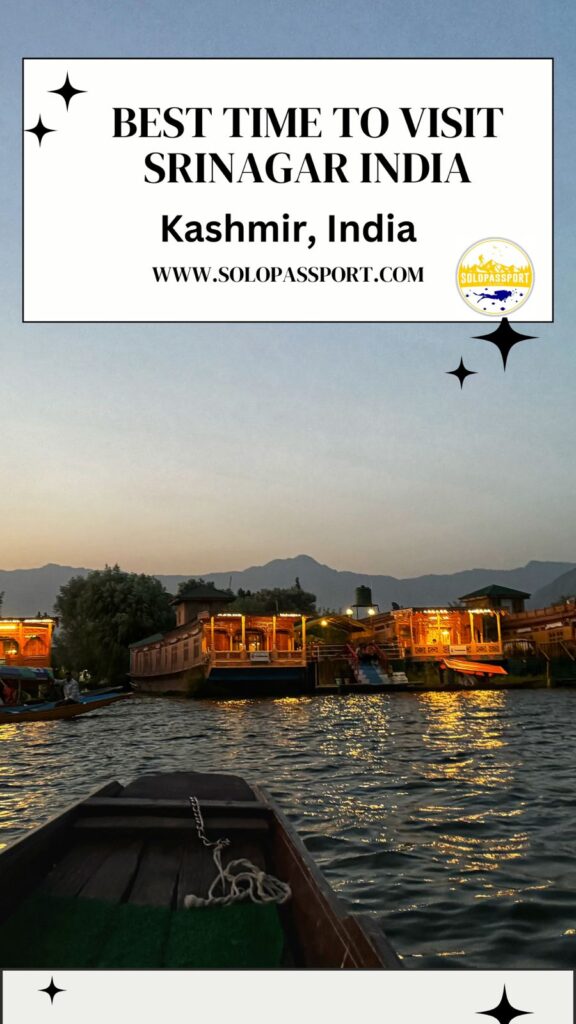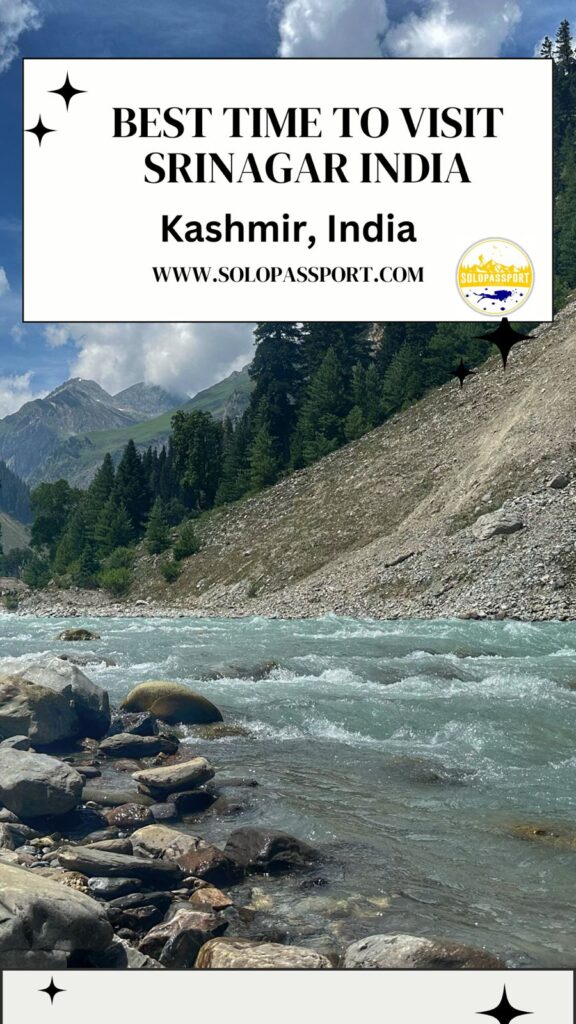Best Time To Visit Srinagar, India (2025)
Did you know that Kashmir is often referred to as heaven on Earth? It is so pristine and beautiful that there is no bad picture of Kashmir. In this post, I will share the best time to visit Srinagar India. Choosing the best time to visit Srinagar can enhance your experience of this enchanting city.
Each season in Srinagar offers a unique charm and set of activities. From the snow-covered winters perfect for skiing and enjoying the serene beauty of Dal Lake to the blooming spring when the tulip gardens come alive, there’s always something special.
Summers bring pleasant weather, ideal for exploring the Mughal gardens and houseboats, while autumn paints the city in hues of gold. By understanding the seasonal highlights and planning your trip accordingly, you can make the most of your visit to this captivating destination.
Having been to Kashmir multiple times, I can provide some insights and tips from a solo traveller perspective and from an Indian perspective who has a stereotype of travelling to Srinagar.
I had a week-long workcation in Srinagar on my way back from the Kashmir Great Lakes (KGL) trek. During that time, I explored and travelled to various places in the city. Srinagar, especially Dal Lake, is one of the most picturesque and warm places I have visited.
I recently visited Srinagar for the Amarnath Yatra Trek and spent a few days exploring the city.
This article may contain affiliate links, meaning if you decide to purchase via my links, I may earn a commission at no additional cost to you. For complete information, please see our affiliate disclaimer here.
Page Contents
About Srinagar
Known for its houseboats, lakes, mountains, and gardens, Srinagar is the capital city of Jammu and Kashmir (J&K). Located on the banks of the Jhelum River, Srinagar’s Sanskrit name, Shi-nagara, is mentioned in Kalhana’s Rajatarangini, a 12th-century historical chronicle. The city has a rich history dating back to ancient times and has been a significant cultural and economic centre in the region.
Srinagar is renowned for its beautiful Dal Lake, which is lined with traditional houseboats and Shikaras and provides a unique way to experience the serene waters. The Mughal Gardens, such as Shalimar and Nishat Bagh, reflect the city’s historical importance and are prime examples of Mughal horticultural elegance. The city is also known for its vibrant markets, which sell traditional Kashmiri handicrafts, pashmina shawls, and saffron.
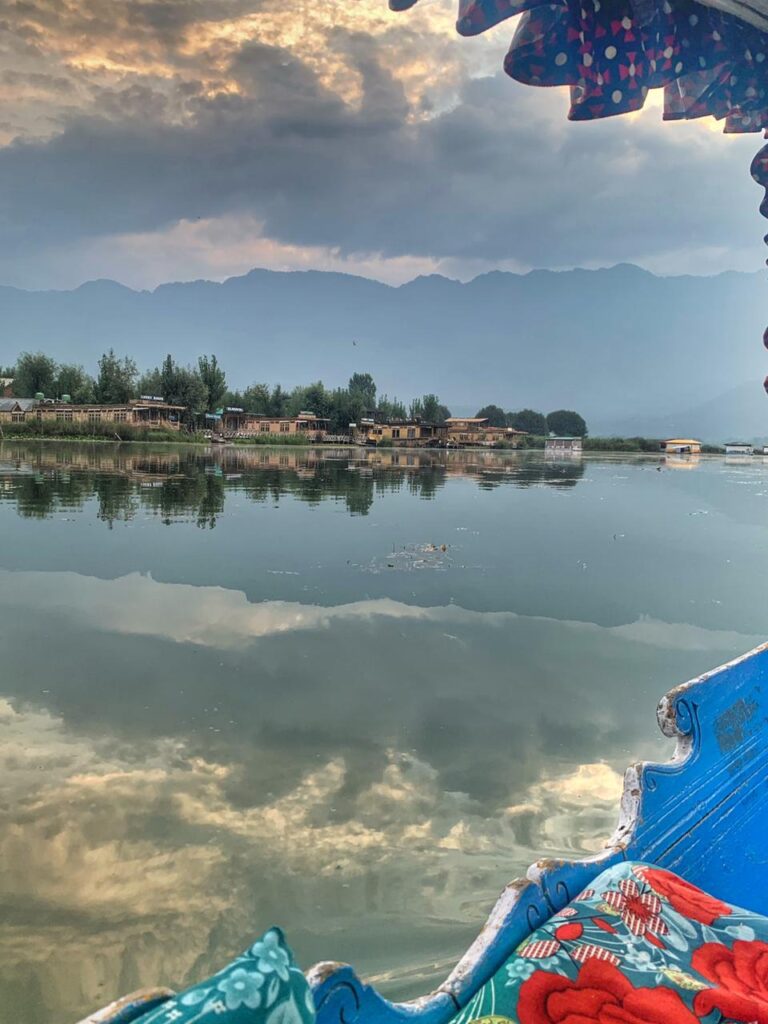
In recent years, Srinagar has seen significant developments to boost tourism and improve infrastructure. However, the city has faced challenges due to political unrest and natural disasters, such as the 2014 floods.
Despite these challenges, Srinagar remains a popular destination for tourists seeking to experience its natural beauty, rich culture, and warm hospitality. Its people’s resilience and efforts to preserve their heritage continue to make Srinagar a fascinating place to visit.
Best Time to Visit Srinagar
Srinagar is beautiful every season, with stunning landscapes and mountains year-round. However, the best time to visit Srinagar depends on the experience you’re looking for, as each season offers its unique charm.
Spring (March to May): Spring is when Srinagar truly comes alive. The mild temperatures range from 10°C to 25°C, making it ideal for outdoor activities. Tulips bloom in the famous Indira Gandhi Memorial Tulip Garden, creating a vibrant and colourful landscape. Mughal Gardens like Shalimar Bagh and Nishat Bagh are in full bloom, making it a perfect time for sightseeing.
Summer (June to August): Summer in Srinagar is pleasant, with temperatures between 15°C and 30°C. This is the best time for houseboat stays on Dal Lake and Shikara rides. The weather is perfect for exploring the city’s attractions and enjoying the serene beauty of the lakes and gardens. The cool mountain breeze relieves the heat experienced in other parts of India.
Autumn (September to November): Autumn is considered one of the most beautiful seasons in Srinagar. As the Chinar trees shed their leaves, the entire valley is painted in hues of red, orange, and yellow. The temperatures range from 10°C to 20°C, making it comfortable for exploring. The golden landscape provides excellent opportunities for photography.
Winter (December to February): Visiting Srinagar between December and February is ideal for winter lovers or those wanting to see snow. Temperatures can drop below freezing, and the city often experiences heavy snowfall. This transforms Srinagar into a winter wonderland, perfect for skiing and other snow activities in nearby Gulmarg. The sight of Dal Lake partially frozen and the snow-covered mountains is breathtaking.
The best time to visit Srinagar India is between April and October when the weather is pleasant and not too cold. Most of the treks are open between June and September.
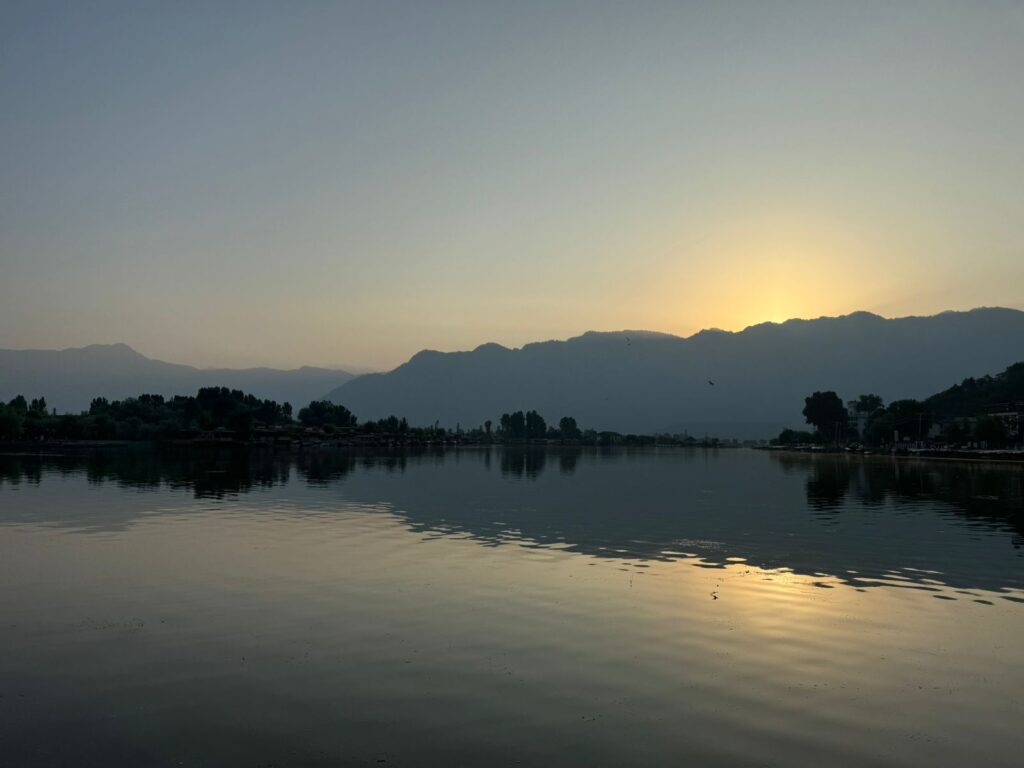
Number of Days Required for Srinagar
You need at least two days in Srinagar to cover all the major places within the city. This includes visiting iconic spots such as Dal Lake, the Mughal Gardens (Shalimar Bagh, Nishat Bagh), Shankaracharya Temple, and the bustling local markets. However, if you wish to explore beyond the city limits and experience the surrounding areas, I recommend allocating at least a week for your trip.
During my recent visit, I spent an entire week in Srinagar. While I enjoyed the extended stay, a week might be too long if your primary goal is sightseeing within the city. The additional days are ideal if you plan to relax, stroll, and explore the city at your own pace.
For those looking to venture out, nearby attractions such as Doodhpathri, Pahalgam, and Sonamarg offer stunning landscapes and exciting activities. These destinations require additional travel time and are well worth the visit. Therefore, if you aim to experience Srinagar and its beautiful surroundings, a week-long stay provides ample time to appreciate the region’s natural beauty, culture, and tranquillity without feeling rushed.
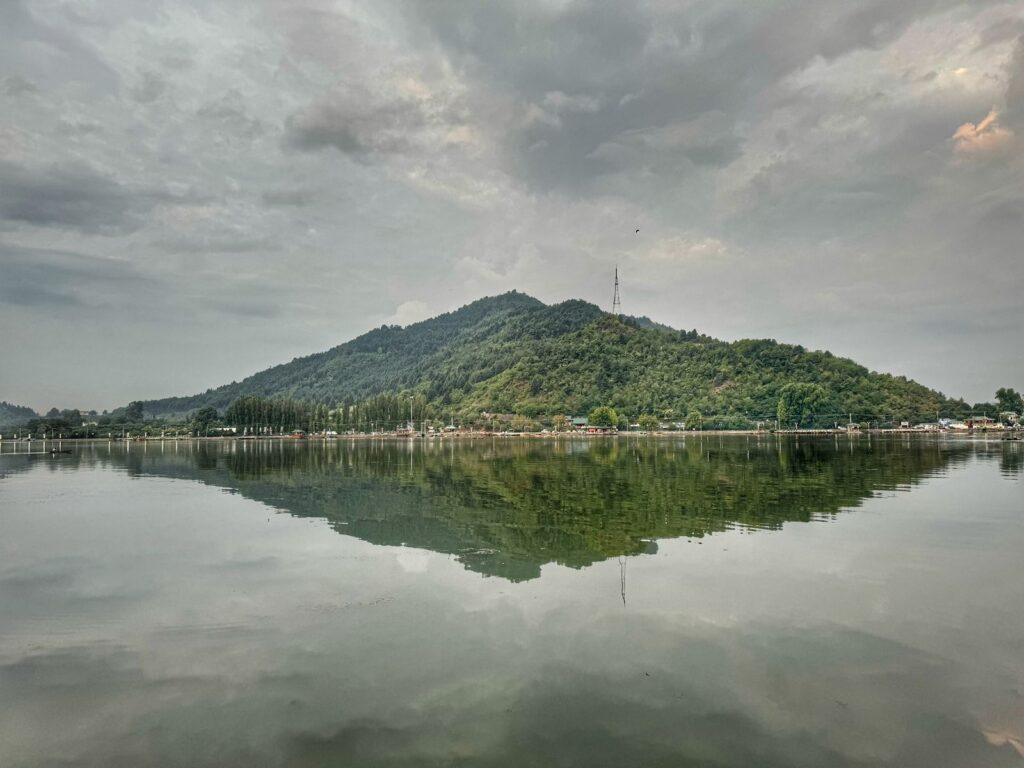
Things to Know Before You Visit Srinagar
- If you do not have a vehicle, the best way to commute within the city is by taking an auto-rickshaw (tuk-tuk). Most auto drivers are good and friendly. I recommend Mehraj (+91 7051870946), who provided reliable service during my stay. Remember to haggle, as fares are often inflated for tourists.
- Be cautious about discussing politics or religion, as past events have left some residents sensitive.
- Respect the local culture by dressing modestly and covering your head when visiting gurdwaras or mosques.
- Be aware that some taxi and auto drivers may become unfriendly if disagreements arise. This happened to me when working with a hotel manager at Lake View Hotel on Dal Lake. Danish, the person in charge, initially promised many services but turned hostile when he couldn’t deliver. I wouldn’t stay there again, though the staff members were kind.
- You will notice a strong presence of CRPF personnel, especially after 6 PM. It’s best to return to your hotel before sunset.
- Solo travellers, particularly women, may encounter unwanted stares, touches, or teasing. Avoid these situations and stay alert to ensure your safety.
10 Places to See in Srinagar
#1 Dal Lake
Dal Lake is an integral part of Srinagar and is often called the “Jewel in the Crown of Kashmir.” As the most visited destination in Srinagar, Dal Lake is also the second-largest lake in Jammu and Kashmir. Its stunning beauty and serene environment make it a top attraction for locals and tourists.
You can indulge in a variety of activities. From leisurely Shikara rides to exploring the floating markets, there’s something for everyone. The lake’s calm waters and picturesque surroundings provide a perfect backdrop for photography and relaxation.
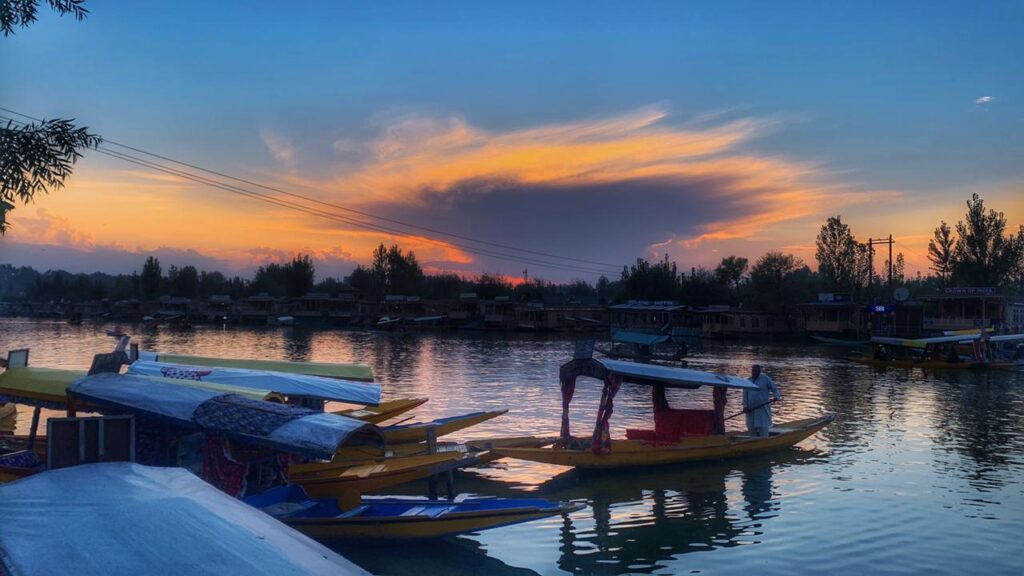
One of the most unique experiences at Dal Lake is staying on a houseboat. These beautifully crafted houseboats offer a glimpse into the traditional Kashmiri lifestyle while providing modern comforts. You can wake up to serene views of the lake, enjoy the tranquillity of the water, and experience the hospitality of the local people. This distinctive accommodation option is a highlight for many travellers, making their visit to Dal Lake memorable.
#2 Lal Chowk
Lal Chowk is a vibrant shopping hub in Srinagar renowned for its local products and souvenirs. It is also historically significant as the site where Jawaharlal Nehru, the first Prime Minister of India, unfurled the national flag in 1948.
When visiting Lal Chowk, I found it a fantastic place to shop for clothing adorned with distinctive Kashmiri designs. The variety of traditional garments was truly impressive, showcasing Kashmiri craftsmanship’s unique and intricate artistry. Each piece, from shawls to embroidered jackets, reflected the region’s rich cultural heritage. The shopping experience at Lal Chowk was enjoyable, and I had the chance to take home beautiful and authentic souvenirs from Srinagar.
#3 Hazratbal Masjid
The Hazratbal Masjid, renowned for housing the Moi-e-Muqqadas, a strand of Prophet Muhammad’s beard, is a prominent religious site in Srinagar. The mosque’s current structure, completed in 1979, replaced the original building from the 17th century, which was erected during Shah Jahan’s reign. The new building stands as a significant religious landmark known as Dargah Sharif.
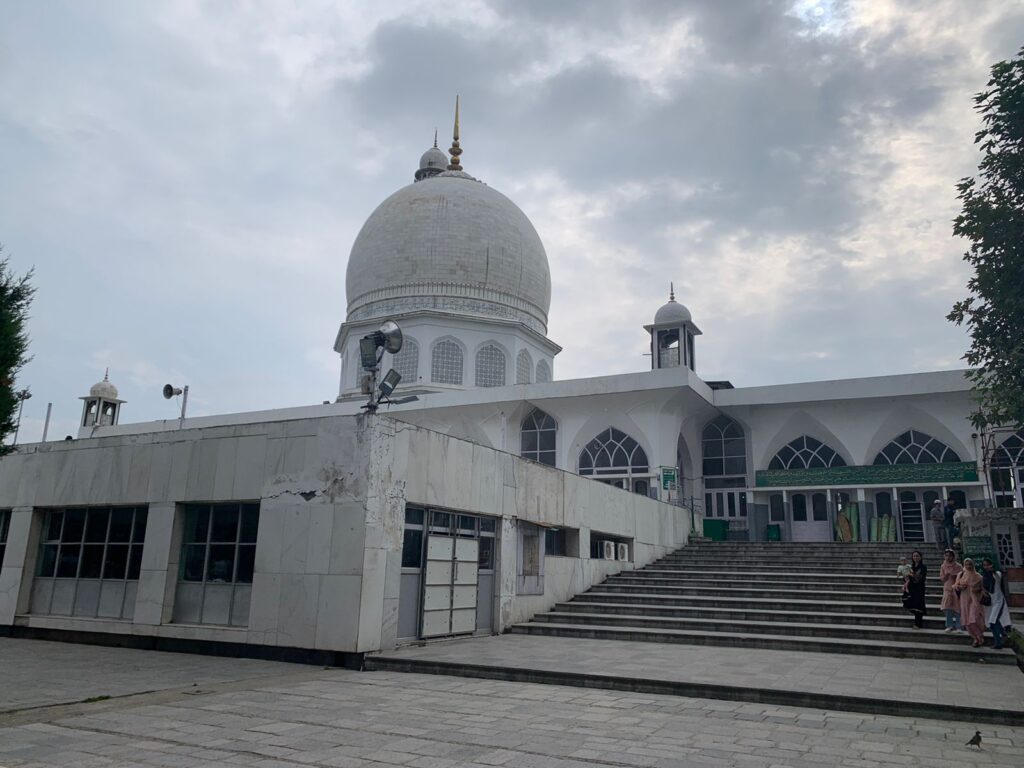
When visiting Hazratbal Masjid, it is essential to dress modestly and cover your head as a sign of respect. The mosque is sacred, and adhering to these dress codes ensures a respectful and appropriate visit.
#4 Zeashta Devi Temple
Zeashta Devi Temple, located in Srinagar, is a revered Hindu shrine dedicated to the goddess Zeashta Devi, an important deity in Kashmiri Hinduism. Situated on the banks of the Dal Lake, this temple is one of the prominent pilgrimage sites for Kashmiri Pandits, the Hindu community indigenous to the region.
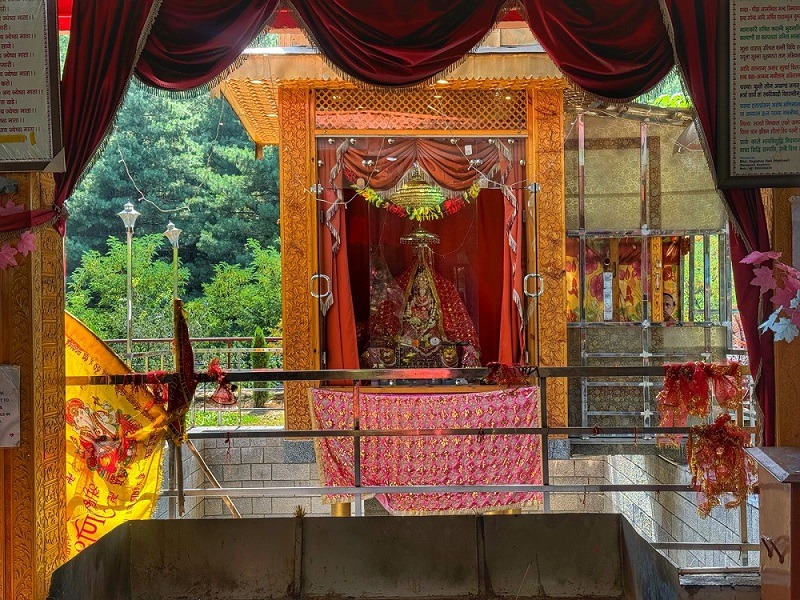
The temple is believed to be one of the ancient sites where the goddess Zeashta Devi was worshipped since antiquity. It holds a significant place in the religious and cultural life of Kashmiri Pandits, who consider the goddess a symbol of purity and protection. The temple’s location, surrounded by lush greenery and overlooking the serene waters of Dal Lake, adds to its spiritual ambience and appeal.
The Zeashta Devi Temple also has historical importance, reflecting the rich heritage of Kashmiri Pandits. It remains a central place of worship for the community, especially during festivals and religious ceremonies. Despite the challenges faced by Kashmiri Pandits over the years, including displacement, the temple continues to serve as a beacon of their enduring cultural and religious traditions.
#5 Shankaracharya Temple
Shankaracharya Temple, perched atop Shankaracharya Hill in Srinagar, is a revered Hindu shrine dedicated to Lord Shiva. The temple is situated at an elevation of about 1,000 meters above the city, offering panoramic views of Srinagar and Dal Lake. Its historical and spiritual significance and breathtaking location make it a prominent landmark in the region.
The temple’s origins are believed to date back to ancient times, though it was rebuilt in the 9th century by the famous Hindu philosopher Adi Shankaracharya. The temple’s architecture is notable for its intricate carvings and serene surroundings, which contribute to its spiritual ambience.
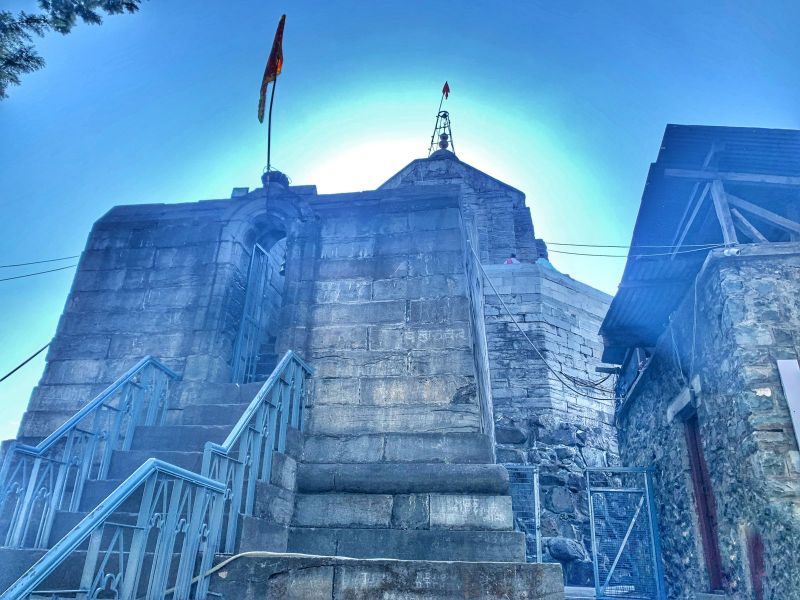
You must ascend a series of steep steps to reach the temple, which adds to the sense of pilgrimage. The climb, however, is rewarded with a stunning view of the city and the lake below. The temple is a significant site for devotees and offers a peaceful retreat from the hustle and bustle of city life. Dress modestly and observe the site’s sacredness.
#6 Nigeen Lake
Nigeen Lake, often called the “Sister of Dal Lake,” is a tranquil and picturesque water body in Srinagar. Situated just a short distance from the more famous Dal Lake, It is less crowded and offers a serene alternative for those seeking a quieter experience.
The lake is known for its clear blue waters and charming houseboats, which provide a unique opportunity to enjoy its beauty from a traditional Kashmiri floating residence. The scenery, with lush gardens and snow-capped mountains in the distance, creates a breathtaking backdrop for relaxation and leisurely activities.
Nigeen Lake is an excellent spot for Shikara rides, where you can experience the traditional wooden boats and explore the lake’s scenic beauty. The area around the lake is also ideal for peaceful strolls along its banks, allowing visitors to immerse themselves in the natural beauty of Kashmir.
The lake’s calm and serene environment makes it a perfect place for reflection and relaxation, away from the hustle and bustle of city life. Its serene setting and picturesque views ensure a memorable visit for anyone exploring Srinagar.
#7 Pari Mahal
Pari Mahal, also known as the “Palace of the Fairies,” is a historical monument on the slopes of the Zabarwan Range overlooking Dal Lake in Srinagar. Built in the 17th century by Dara Shikoh, the eldest son of the Mughal Emperor Shah Jahan, this architectural marvel reflects a unique blend of Persian and Mughal styles.
The palace is renowned for its beautiful terraced gardens, a prominent site feature. These gardens, designed to mimic the heavenly gardens of paradise, offer spectacular views of Dal Lake and the surrounding landscape. The terraced levels of Pari Mahal were designed not only for aesthetic appeal but also to enhance the area’s natural beauty.

The structure has six floors, each offering panoramic views of the lake and distant mountains. Though partially worn, the ruins still convey the grandeur and elegance of the original design. Pari Mahal holds historical significance as a centre of learning and culture during its time, and it remains a popular destination for visitors seeking to explore Kashmir’s rich heritage and enjoy breathtaking vistas.
#8 Jamia Masjid
Jamia Masjid Srinagar is a historic and significant mosque located in the heart of Srinagar’s old city. Built in the 14th century by Sultan Sikandar, the mosque is a remarkable example of Kashmiri architecture and Islamic artistry. Its large prayer hall, supported by 378 wooden pillars, is a striking feature, showcasing the region’s traditional craftsmanship.
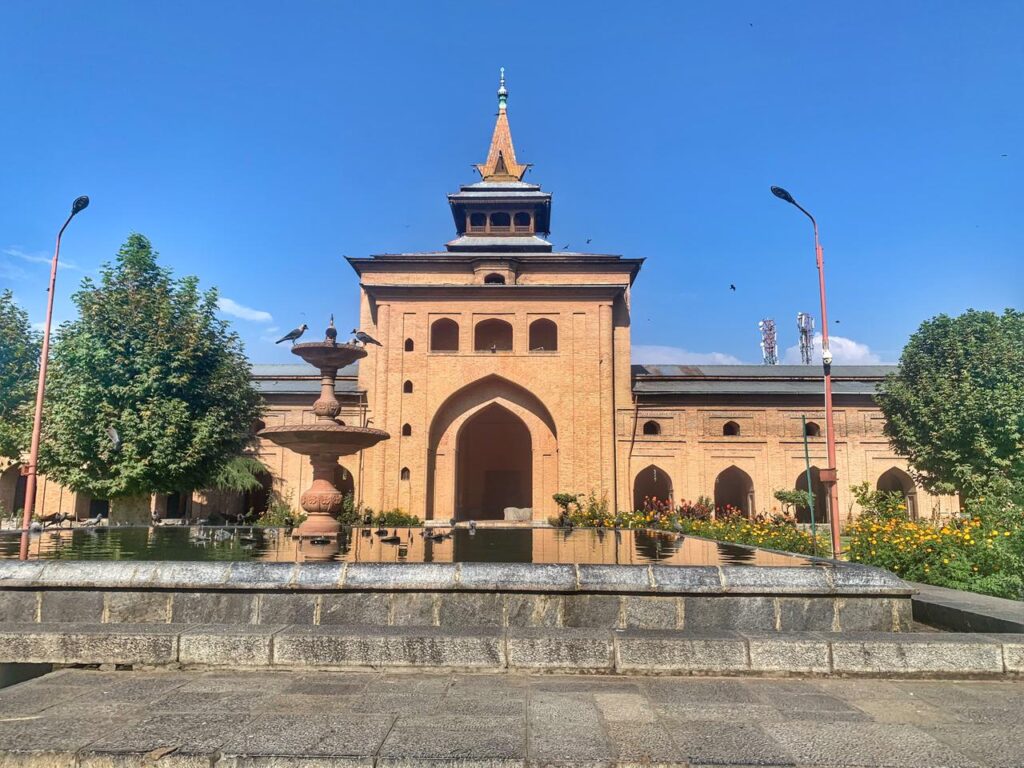
The mosque’s design is notable for its blend of Persian and Central Asian architectural styles, characterised by its wooden ceilings, intricately carved pillars, and spacious courtyards. The expansive prayer hall can accommodate thousands of worshippers, reflecting the mosque’s importance as a central place of worship in Srinagar.
The mosque is surrounded by a large courtyard often used for congregational prayers and religious gatherings. The tranquil atmosphere and the mosque’s historic ambience make it a revered site for locals and visitors. Visitors are expected to dress modestly and remove their shoes before entering. Jamia Masjid is not only a significant religious site but also a cultural landmark that offers a glimpse into Kashmir’s architectural and historical heritage.
#9 Hari Parbat Fort
Hari Parbat Fort, located on Hari Parbat Hill in Srinagar, is a historic fortress that offers stunning panoramic views of the city and the surrounding landscape. The fort is strategically positioned on a hill about 1,800 meters above sea level, providing a commanding view over Srinagar and Dal Lake.
The fort was constructed in the 16th century by the Mughal Emperor Akbar to consolidate his rule in Kashmir. It was built on the site of an earlier structure, and its construction marked a significant moment in the region’s history. The fort’s architecture reflects a blend of Mughal and Persian influences, with its imposing walls and strategic design serving defensive and administrative purposes.
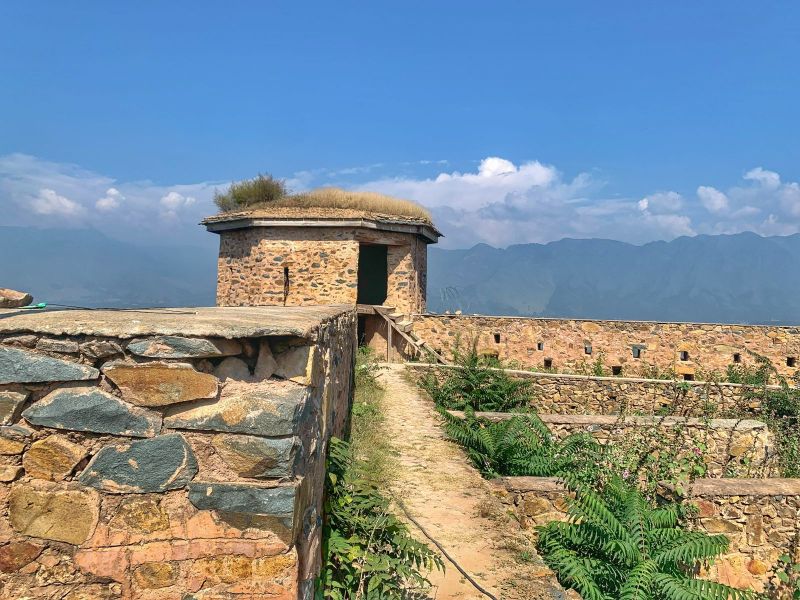
In addition to its military significance, Hari Parbat Fort is surrounded by a large defensive wall and a moat, adding to its historical and architectural intrigue. The fort is also associated with local legends and has religious significance, standing near several important Hindu and Muslim shrines.
Hari Parbat Fort is a popular tourist destination, attracting visitors with its historical charm, breathtaking views, and cultural significance.
#10 Floating Post Office
The Floating Post Office in Srinagar is a unique and charming landmark on Dal Lake. Established in 2011, it is the world’s only floating post office, housed on a traditional wooden houseboat. This distinctive post office combines the functionality of a postal service with the picturesque beauty of Dal Lake, making it a popular attraction for locals and tourists.
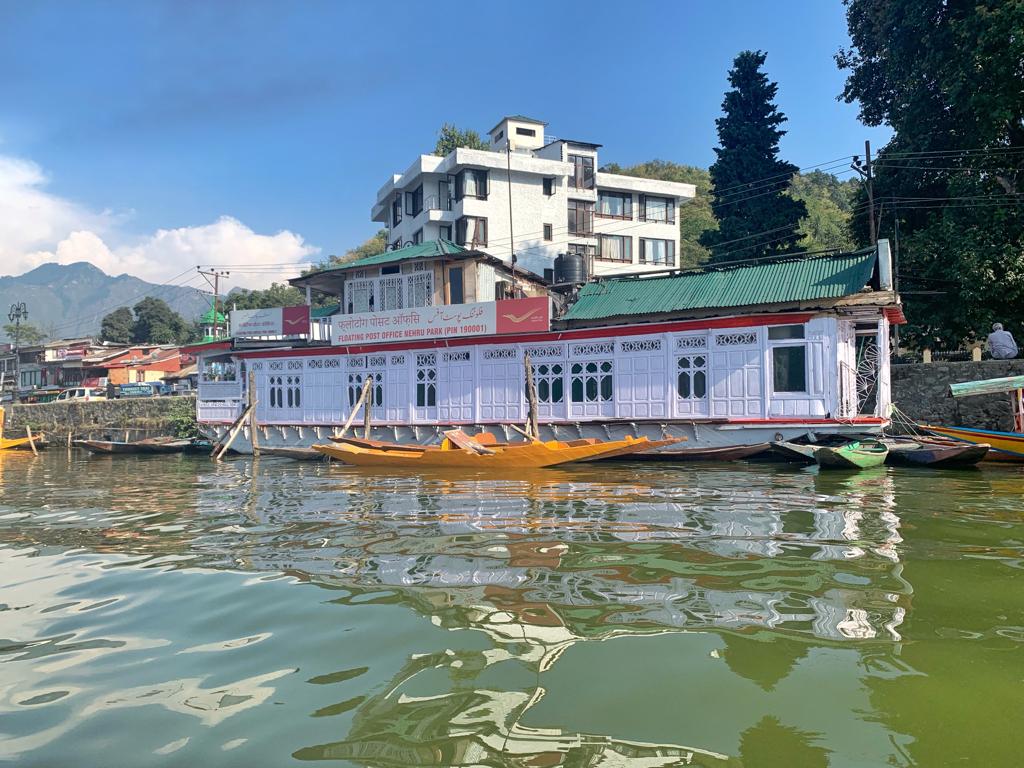
The floating post office is housed on a meticulously crafted houseboat, reflecting traditional Kashmiri architecture and design. Its location allows visitors to enjoy the serene waters of Dal Lake while sending postcards or letters. The post office offers standard postal services, including mailing letters, purchasing stamps, and sending parcels.
In addition to its practical functions, the Floating Post Office has become a symbol of Srinagar’s unique blend of tradition and modernity. It is adorned with traditional Kashmiri motifs and offers a charming and memorable experience for those wishing to send mail from this one-of-a-kind location. The post office also features a small museum showcasing the history of the postal system in Kashmir, adding an educational aspect to the visit.
Where to Stay in Srinagar?
When planning a stay in Srinagar, you have several accommodation options, from luxurious houseboats to cosy hotels. Here are some recommendations based on different preferences:
1. Houseboats:
- Nigeen Lake and Dal Lake: Staying on a houseboat provides a unique experience. Some famous houseboats include the Houseboat Zaindari Palace and the Prince of Kashmir Luxury Houseboat. These offer beautiful views, traditional Kashmiri decor, and a serene environment.
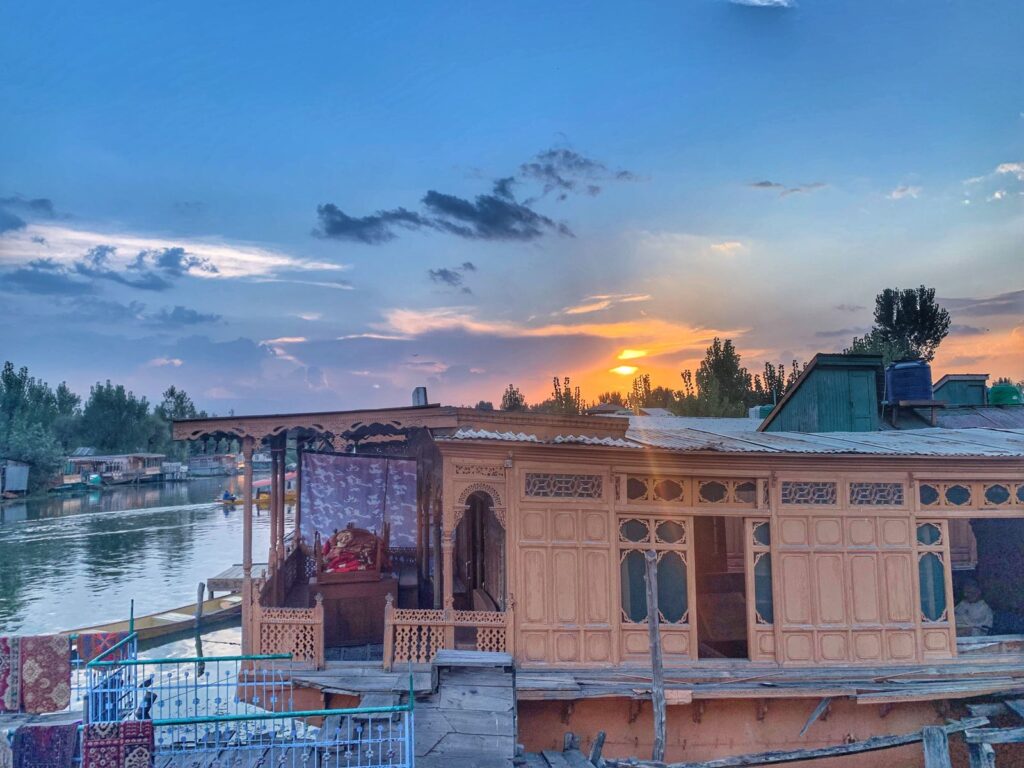
2. Luxury Hotels:
- The Lalit Grand Palace: Located on the banks of Dal Lake, this 5-star hotel offers elegant rooms, stunning views, and top-notch amenities.
- Vivanta Dal View: This hotel offers luxurious accommodations with panoramic views of Dal Lake. It provides excellent facilities and a serene atmosphere.
3. Boutique Hotels:
- Hotel Grand Boulevard: Situated near Dal Lake, this boutique hotel offers comfortable rooms and personalized service in a charming setting.
- Apple Orchard Resort and Spa: Located in the heart of Srinagar, this boutique hotel combines modern amenities with traditional Kashmiri hospitality.
4. Budget Accommodations:
- Zostel Srinagar: A budget-friendly hostel option near Dal Lake that provides clean rooms and basic amenities.
- Whostels: Located in the city centre, this hostel offers affordable rates and convenient access to local attractions.
How to Get to Srinagar?
By Air
To reach Srinagar by air, book a flight to Sheikh ul-Alam International Airport, the city’s primary airport. Several airlines, including Air India, IndiGo, and Vistara, offer flights from major Indian cities such as Delhi, Bangalore, and Mumbai.
The flight from Delhi to Srinagar takes about 1 hour and 15 minutes. From Mumbai, the journey is approximately 2 hours and 30 minutes, often including a layover. Flights from Bangalore to Srinagar typically take around 3 hours and 30 minutes. Upon arrival at the airport, you will find essential amenities like baggage services and car rental counters. For transportation to your destination, you can choose from taxis or prepaid taxi counters available at the airport. The fare from the airport to Dal Lake generally ranges between INR 1000 and INR 1500 one way.
When departing from Srinagar, planning for extra time at the airport is crucial. You’ll need to get your suitcases and luggage scanned at a facility about a kilometre from the terminal. Keep your ticket and ID handy; you must present them to CRPF officials for verification. This additional step helps streamline the security process and ensures a smoother departure.
By Public Transport
Travelling to Srinagar by bus or train involves more planning than flying, but it can be a scenic and economical option. Here’s how you can do it:
By Bus
- From Major Cities:
- Delhi: Private and state-run buses operate services from Delhi to Srinagar. The journey usually takes 12 to 16 hours, depending on traffic and road conditions. Buses typically depart from the ISBT (Inter-State Bus Terminal) in Delhi.
- Jammu: If you are travelling from Jammu, there are frequent bus services to Srinagar. The drive takes approximately 6 to 8 hours and covers a distance of about 300 kilometres.
- Types of Buses:
- Volvo/Deluxe: For a more comfortable journey, you can opt for Volvo or Deluxe buses which provide better amenities and are less crowded.
- Regular Buses: These are more economical but may be less comfortable.
- Booking:
- You can book bus tickets online through various travel websites like RedBus or at the bus terminals. It’s advisable to book in advance, especially during peak tourist seasons.
By Train
- Train to Jammu:
- Delhi to Jammu: Take a train from Delhi to Jammu, the nearest major railway station to Srinagar. The journey takes approximately 8 to 10 hours. Trains like the Jammu Rajdhani Express, Jammu Mail, and Jammu Rajdhani are popular choices.
- Other Cities: Trains from other cities, such as Amritsar or Chandigarh, also connect to Jammu.
- From Jammu to Srinagar:
- By Bus: You can take a bus to Srinagar from Jammu, which takes about 6 to 8 hours. Buses are available from Jammu’s Bus Stand or through private operators.
- By Taxi: For a more private and direct option, you can also hire a taxi from Jammu to Srinagar.
- Booking:
- Train tickets can be booked online through the IRCTC website or at railway station counters. For buses or taxis from Jammu to Srinagar, you can book tickets online, directly at the bus stands, or through local travel agencies.
Is Srinagar Safe for Solo Female Travellers?
Srinagar is generally safe for solo female travellers, but taking certain precautions is important to ensure a smooth and enjoyable visit. Dressing modestly is advisable, as it aligns with local customs; covering your arms and legs and carrying a headscarf for religious sites can be helpful.
Opt for reputable accommodations with good security and consider pre-booking transportation through your hotel or a trusted service provider, especially if you must travel late. Avoid isolated or poorly lit areas, and keep a close eye on your belongings.
Staying informed about local news and travel advisories and sharing your itinerary with family or friends can also enhance your safety. Respectfully engaging with locals and being aware of cultural norms will further enrich your travel experience. With its vibrant tourism scene, Srinagar can be a rewarding destination for solo female travellers when these safety measures are followed.
Closing Notes
With its breathtaking landscapes, rich cultural heritage, and unique experiences, Srinagar is undoubtedly a remarkable destination for travellers. Whether you’re drawn to the serene beauty of Dal Lake, the historic charm of Pari Mahal, or the vibrant atmosphere of local markets, Srinagar offers something for everyone. As a solo female traveller, embracing the local customs, planning your trip carefully, and staying informed will help ensure a memorable and safe journey.
If you’re ready to explore Srinagar’s enchanting beauty, start planning your trip today. Research accommodations that best suit your preferences, book your flights and transportation in advance and make a checklist of must-see attractions. Don’t forget to stay connected with family and friends, share your itinerary, and seek advice from locals to enhance your travel experience.
Srinagar awaits with its warm hospitality and captivating sights, promising an adventure that you’ll cherish for years to come. So, pack your bags, embark on this unforgettable journey, and let the magic of Srinagar unfold before you. Please ask for tips and recommendations if you have any questions or need further assistance with your travel plans.
Disclaimers:
- The prices mentioned in the post are valid only at the time of publication. Ensure that you check the booking websites for up-to-date information and prices.
- My opinions and views are unbiased. If the post is a collaboration, then they are specifically mentioned.
- Ensure that you check the relevant websites for up-to-date information on COVID protocols.
- For any adventurous activities, please note that there is a risk that can be dangerous. Ensure you read the terms and conditions recommended by individual agencies and do them at your own risk.
- For visas, it is best to see the embassy website for changing rules.
- While using the recommended guides, auto-drivers or taxi drivers, do your due diligence and trust your judgement.
How can you support me?
You know how much I love coffee, so you can buy me a coffee – Buy me Coffee!
Or you can purchase from one of the below travel resources without any extra charge to you:
Travel Resources
Book your flight on Skyscanner.com or Trip.com
Reserve your accommodation on Stay22
Reserve your stay at a hostel on HostelWorld
Use RentalCars or DiscoverCars for hiring self-driven cars
Book your tours and travels or purchase tickets on Viator or GetYourGuide
For a universal SIM card, use DrimSim
Buy comprehensive travel insurance on SafetyWing and WorldNomads
If you liked this article and if it was helpful in your planning or travelling, do share, tweet, or pin this post.
Follow me on Instagram | Facebook | YouTube | Twitter | LinkedIn
Do you have a question? Do you want any suggestions and tips for travel, hikes, and scuba dives? Use the Subscription box below to sign up and get updates by email.
PIN for later reference – Best Time to Visit Srinagar India
